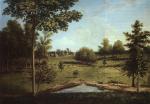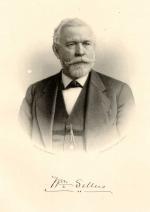![header=[Marker Text] body=[First permanent home in Upper Darby, built about 1684 by Samuel Sellers who occupied it with his bride, Anna Gibbons. Their son, Samuel Sellers, Jr., was the first of many family members active in mechanical and scientific pursuits. Birthplace of John Sellers, a founder of the American Philosophical Society. In 1769 he served on a select committee that observed the planet Venus in its passage across the sun.] sign](http://explorepahistory.com/kora/files/1/10/1-A-393-139-ExplorePAHistory-a0m4l8-a_450.jpg)
Mouse over for marker text
Name:
Sellers Hall
Region:
Philadelphia and its Countryside/Lehigh Valley
County:
Delaware
Marker Location:
N side of Walnut St. between Copley and Glendale Rds., Upper Darby.
Dedication Date:
October 25, 1985
Behind the Marker
Many Pennsylvania settlers tended farms and simultaneously practiced a trade, but the Sellers family took that versatility to a new level. They were disciples of the Enlightenment, believing like Benjamin Franklin and David Rittenhouse, that reason and scientific knowledge could improve the human condition. One Sellers generation after another reflected that mindset. From the family's initial farming and weaving enterprises, Sellers descendants were among the engineers, mechanics, and scientists who over three centuries changed Pennsylvania and the nation from an agrarian culture into an industrial society.
Benjamin Franklin and David Rittenhouse, that reason and scientific knowledge could improve the human condition. One Sellers generation after another reflected that mindset. From the family's initial farming and weaving enterprises, Sellers descendants were among the engineers, mechanics, and scientists who over three centuries changed Pennsylvania and the nation from an agrarian culture into an industrial society.
It all began with Samuel Sellers (1655-1732), a member of the Religious Society of Friends, who moved to Pennsylvania to escape persecution in England. In 1682, Sellers settled in a wooded area he and others called Darby after Derbyshire, their English home. In two years, Sellers cleared land for farming and built the stone house known as "Sellers Hall." Sellers then started a cloth-weaving business and became America's first wire weaver, making among other things, screens for sifting flour.
Sellers' son, Samuel Sellers Jr. (1690-1773), continued the family farming and weaving businesses. Recognizing the need for better quality wool cloth, he developed a machine that twisted wool into worsted yarn. (Worsted wool cloth was a fine, light fabric perfect for year-round clothing). Samuel Jr. became famous for his woolen camlets (durable outerwear garments) and coverlets (bedspreads). He also designed tools and machines for wire weaving, which he hid to protect his manufacturing process.
Like his father and grandfather, John Sellers (1728-1804) was a farmer and weaver, but he was also an entrepreneur, manufacturer, politician, patriot, surveyor, and amateur scientist. He diversified the family farm in 1752 by building a gristmill on Cobb's Creek, which ran through the Sellers' property. The water-powered gristmill sported the latest technology, including John's wire rolling screens, sieves, and time-saving machines that removed chaff from grains before processing and bran from flour after milling. John also advertised and sold his wire rolling screens. When the market for milling screens declined, he diversified again in the 1770s, constructing a sawmill, complete with mechanical ripsaws, new facilities for drawing wire, a linseed-oil mill and a tannery.
sold his wire rolling screens. When the market for milling screens declined, he diversified again in the 1770s, constructing a sawmill, complete with mechanical ripsaws, new facilities for drawing wire, a linseed-oil mill and a tannery.
John was also a skillful, self-taught surveyor, like his peers George Washington and Andrew Ellicott (known for his work on the Mason-Dixon survey and for plotting the boundary between the U.S. Mississippi Territory and Spanish West Florida). Surveying required a thorough grounding in mathematics, and 18th century surveyors were Enlightenment-era specialists who applied mathematical principles to determine boundaries. In the New World, surveying was particularly important. Colonial borders had to be accurately measured. Rivers and mountains needed to be surveyed to determine the best course for the roads and canals.
Andrew Ellicott (known for his work on the Mason-Dixon survey and for plotting the boundary between the U.S. Mississippi Territory and Spanish West Florida). Surveying required a thorough grounding in mathematics, and 18th century surveyors were Enlightenment-era specialists who applied mathematical principles to determine boundaries. In the New World, surveying was particularly important. Colonial borders had to be accurately measured. Rivers and mountains needed to be surveyed to determine the best course for the roads and canals.
John left his surveyor's mark on large parts of Pennsylvania. He performed numerous road and property surveys, including those for a proposed road between Philadelphia and Lancaster, and for marking the boundary line between Chester and Delaware counties. He also surveyed the Schuylkill and Susquehanna rivers to determine if the two could be linked John continued this work as a politician, serving on committees responsible for making surveys as a member of the Pennsylvania Assembly.
John openly supported the Continental Congress and Army during the American Revolution in defiance of Quaker pacifist teaching. He owned and operated businesses that benefited the troops, producing saltpeter (for gunpowder), wire brushes, priming picks, and tent poles. With his sons Samuel and Nathan, he signed and numbered currency issued for the fledgling government by private printers, a practice employed to legitimize the currency and to discourage forgery.
Philadelphia was a center of Enlightenment thought. The European philosophy attracted many American intellectuals pondering how to build a better society. Swept up in the trans-Atlantic wave, John was affiliated with several organizations based on Enlightenment principles, and was a member of the American Philosophical Society.
With fellow member and surveyor David Rittenhouse, he worked on the Society's efforts to study the transit of Venus in 1768, and served on the canal committee, appointed to consider the feasibility of connecting the Delaware River and the Chesapeake Bay. As a founder of the Pennsylvania Society for the Improvement of Roads and Inland Navigation, he lobbied for a permanent bridge over the Schuylkill, an idea he presented to fellow members of the
David Rittenhouse, he worked on the Society's efforts to study the transit of Venus in 1768, and served on the canal committee, appointed to consider the feasibility of connecting the Delaware River and the Chesapeake Bay. As a founder of the Pennsylvania Society for the Improvement of Roads and Inland Navigation, he lobbied for a permanent bridge over the Schuylkill, an idea he presented to fellow members of the  Philadelphia Society for Promoting Agriculture.
Philadelphia Society for Promoting Agriculture.
John's descendants continued the family tradition. Nathan Sellers (1751-1830) made wire moulds for paper. In 1798, Nathan and his brother David built Cardington Mills, Delaware County's first cotton mill, on Cobb's Creek. Nathan's son Coleman built fire engines and leather hoses in his Philadelphia workshop and served on the board that built the Eastern State Penitentiary, a pioneering architectural experiment that applied reason to the "reform" of criminals.
Eastern State Penitentiary, a pioneering architectural experiment that applied reason to the "reform" of criminals.
In 1828, Coleman built Cardington Iron Works, which supplied cotton mills and the Sellers Locomotive Works. Coleman Sellers Jr. (1827-1907) invented a "Kinematascope," (a motion-picture machine). George Sellers (1808-1899) invented surveying equipment and a hill-climbing machine that helped build the Panama Canal. The Sellers were also abolitionists who reportedly sheltered slaves at Sellers Hall as part of the Underground Railroad.
The Sellers family personified the ingenuity, entrepreneurship, tolerance, and patriotism associated with the leading American citizens of their times. They left a lasting legacy, marking the transformation of the United States from a nascent sovereign state to an established world power.
Many Pennsylvania settlers tended farms and simultaneously practiced a trade, but the Sellers family took that versatility to a new level. They were disciples of the Enlightenment, believing like
It all began with Samuel Sellers (1655-1732), a member of the Religious Society of Friends, who moved to Pennsylvania to escape persecution in England. In 1682, Sellers settled in a wooded area he and others called Darby after Derbyshire, their English home. In two years, Sellers cleared land for farming and built the stone house known as "Sellers Hall." Sellers then started a cloth-weaving business and became America's first wire weaver, making among other things, screens for sifting flour.
Sellers' son, Samuel Sellers Jr. (1690-1773), continued the family farming and weaving businesses. Recognizing the need for better quality wool cloth, he developed a machine that twisted wool into worsted yarn. (Worsted wool cloth was a fine, light fabric perfect for year-round clothing). Samuel Jr. became famous for his woolen camlets (durable outerwear garments) and coverlets (bedspreads). He also designed tools and machines for wire weaving, which he hid to protect his manufacturing process.
Like his father and grandfather, John Sellers (1728-1804) was a farmer and weaver, but he was also an entrepreneur, manufacturer, politician, patriot, surveyor, and amateur scientist. He diversified the family farm in 1752 by building a gristmill on Cobb's Creek, which ran through the Sellers' property. The water-powered gristmill sported the latest technology, including John's wire rolling screens, sieves, and time-saving machines that removed chaff from grains before processing and bran from flour after milling. John also advertised and
John was also a skillful, self-taught surveyor, like his peers George Washington and
John left his surveyor's mark on large parts of Pennsylvania. He performed numerous road and property surveys, including those for a proposed road between Philadelphia and Lancaster, and for marking the boundary line between Chester and Delaware counties. He also surveyed the Schuylkill and Susquehanna rivers to determine if the two could be linked John continued this work as a politician, serving on committees responsible for making surveys as a member of the Pennsylvania Assembly.
John openly supported the Continental Congress and Army during the American Revolution in defiance of Quaker pacifist teaching. He owned and operated businesses that benefited the troops, producing saltpeter (for gunpowder), wire brushes, priming picks, and tent poles. With his sons Samuel and Nathan, he signed and numbered currency issued for the fledgling government by private printers, a practice employed to legitimize the currency and to discourage forgery.
Philadelphia was a center of Enlightenment thought. The European philosophy attracted many American intellectuals pondering how to build a better society. Swept up in the trans-Atlantic wave, John was affiliated with several organizations based on Enlightenment principles, and was a member of the American Philosophical Society.
With fellow member and surveyor
John's descendants continued the family tradition. Nathan Sellers (1751-1830) made wire moulds for paper. In 1798, Nathan and his brother David built Cardington Mills, Delaware County's first cotton mill, on Cobb's Creek. Nathan's son Coleman built fire engines and leather hoses in his Philadelphia workshop and served on the board that built the
In 1828, Coleman built Cardington Iron Works, which supplied cotton mills and the Sellers Locomotive Works. Coleman Sellers Jr. (1827-1907) invented a "Kinematascope," (a motion-picture machine). George Sellers (1808-1899) invented surveying equipment and a hill-climbing machine that helped build the Panama Canal. The Sellers were also abolitionists who reportedly sheltered slaves at Sellers Hall as part of the Underground Railroad.
The Sellers family personified the ingenuity, entrepreneurship, tolerance, and patriotism associated with the leading American citizens of their times. They left a lasting legacy, marking the transformation of the United States from a nascent sovereign state to an established world power.
Beyond the Marker







